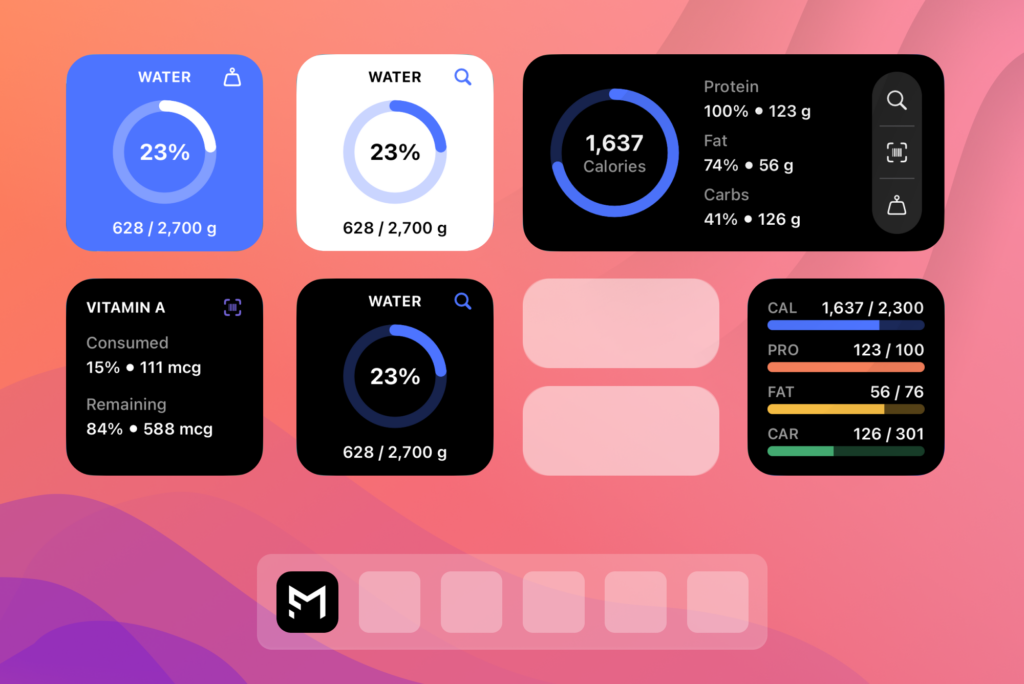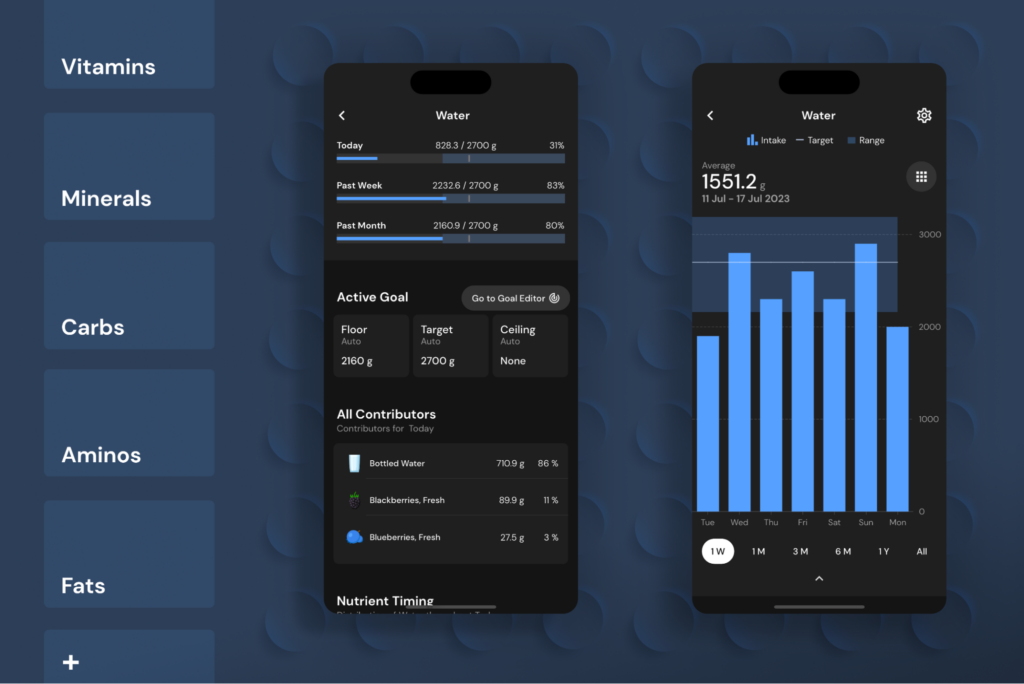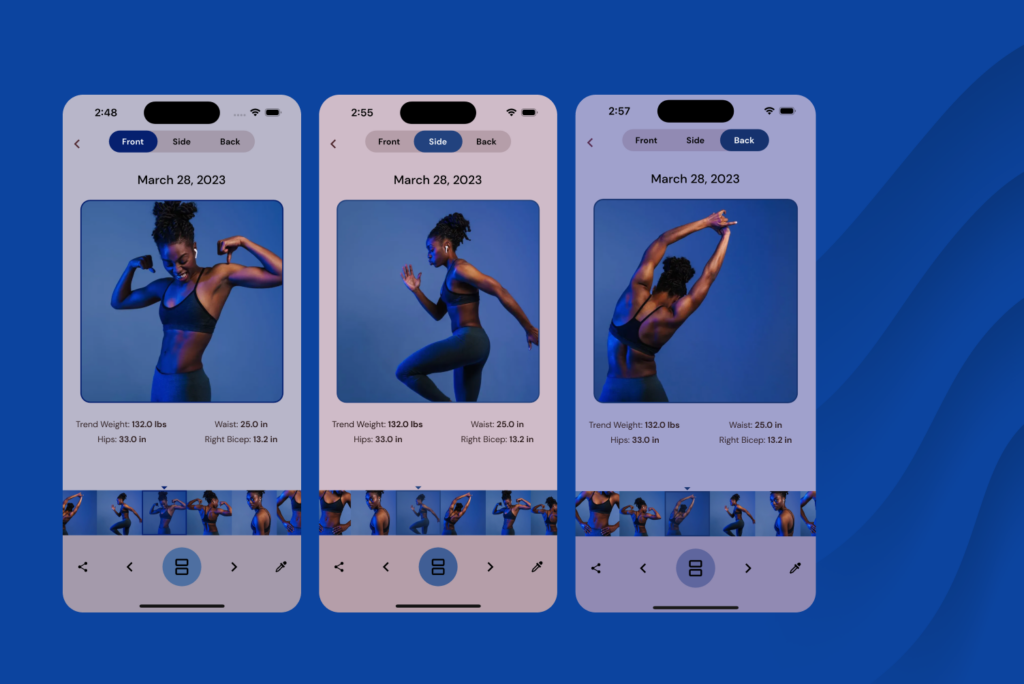Lose weight, gain muscle, maintain results
Reach your diet goals with MacroFactor's best-in-class features
The fastest food logger on the market
Track your meals quickly and easily with ultra-fast food logging utilities.
Plus, all items in MacroFactor’s food search database have been verified, so you can trust the accuracy of the foods you log.
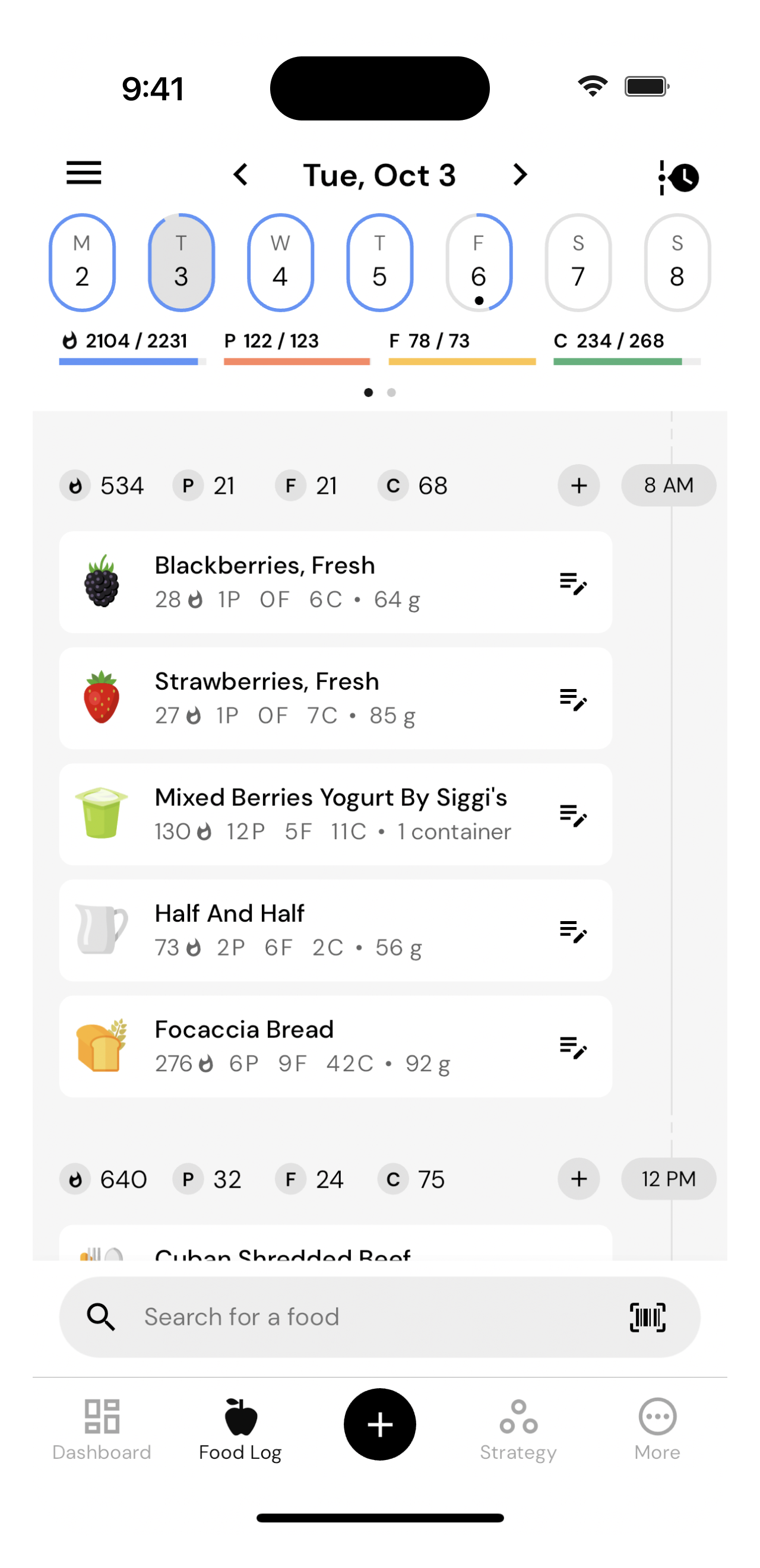
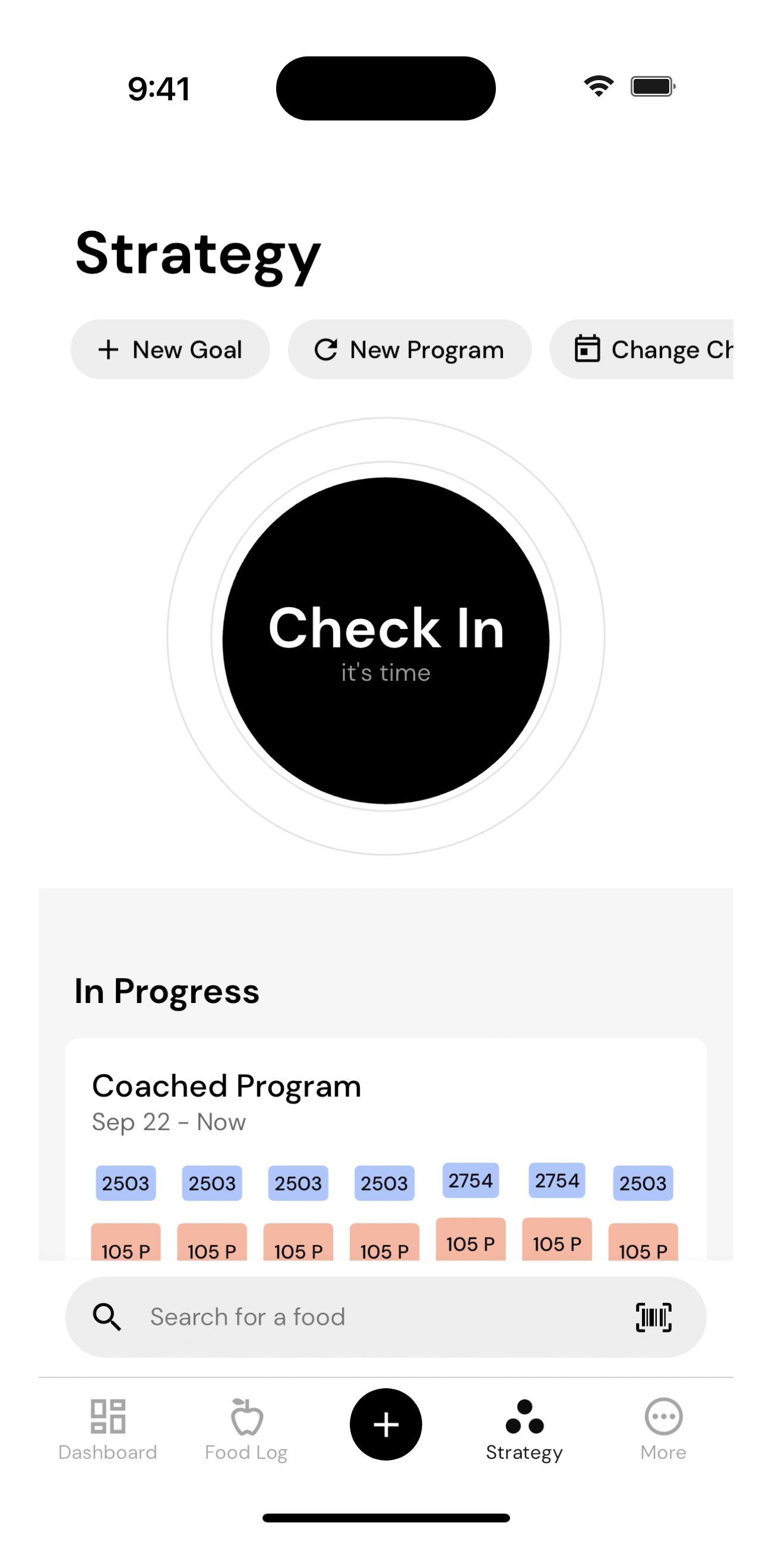
Smart nutrition coaching algorithms
Tell us your goal, and the app will design a plan to get you there. MacroFactor’s smart algorithms personalize your calorie and macro intake targets, just like a nutrition coach would.
Then, just check in weekly to get smart adjustments based on your progress, so you can stay on track toward your goal.
Dynamic energy expenditure calculator
Get a personalized energy expenditure calculation based on your daily nutrition and weight data.
MacroFactor keeps pace with your ever-changing energy needs and updates your expenditure estimate as needed to ensure that your calorie targets are appropriate for your goals.
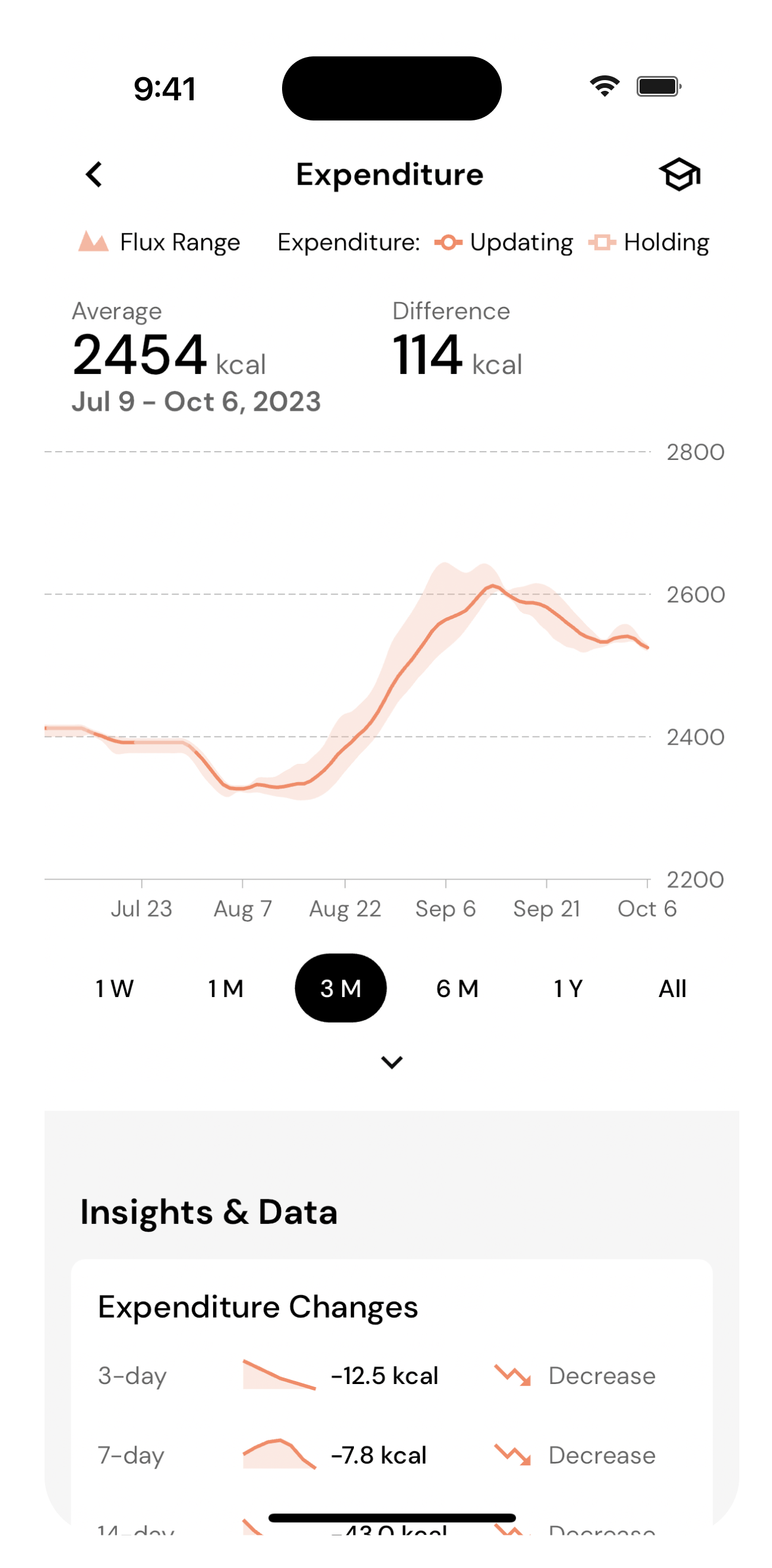
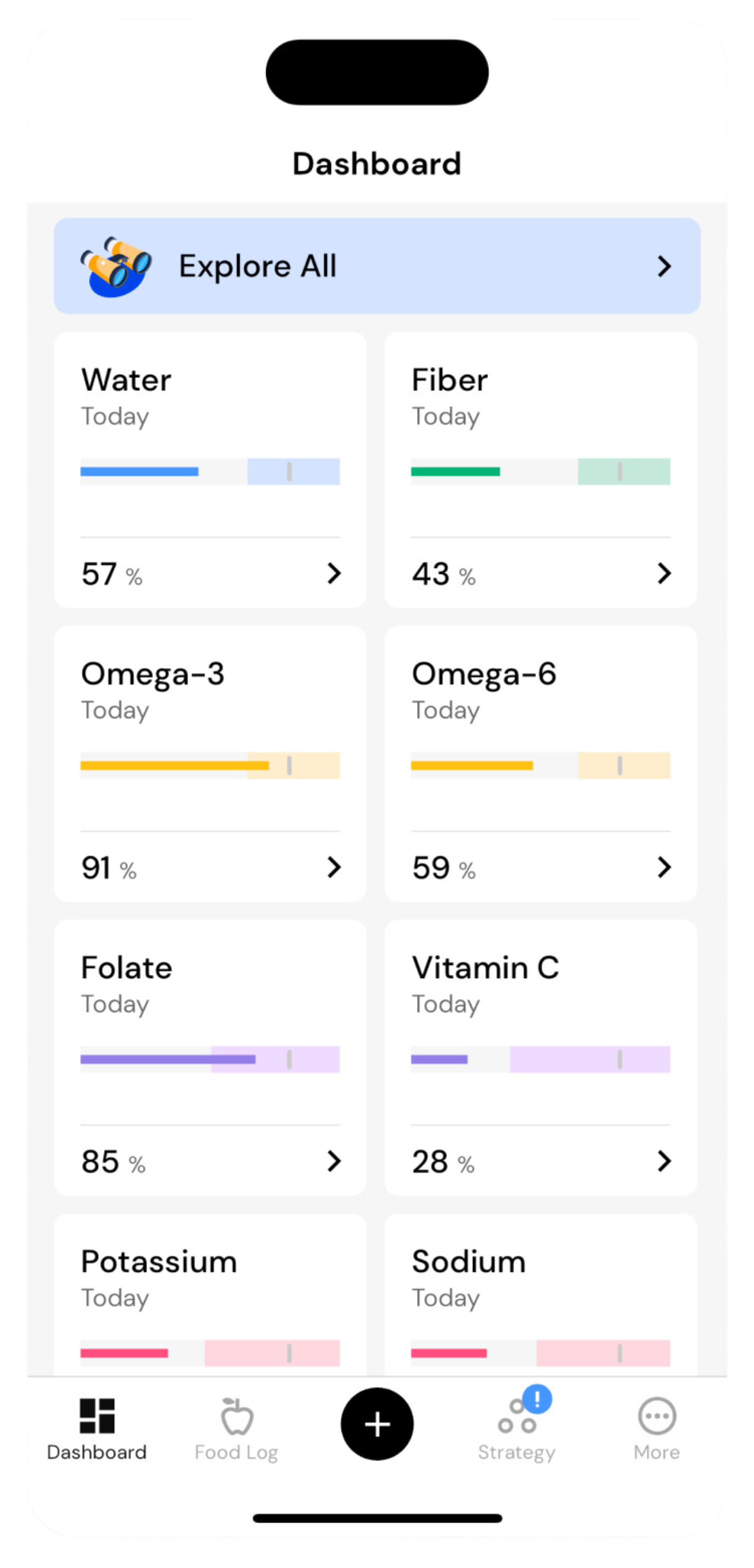
Micronutrient tracker
Enhance your nutrition by tracking the vitamins and minerals that are important to you.
MacroFactor’s comprehensive three-part nutrient goal management lets you set your own floor, target, and ceiling. Plus, beautiful charts and data reporting help you visualize insights on intake timing and dietary habits.
Progress photos and body metrics tracking
Track up to 3 photo views and 21 body metrics, then bring specific metrics into focus and visualize your progress over time.
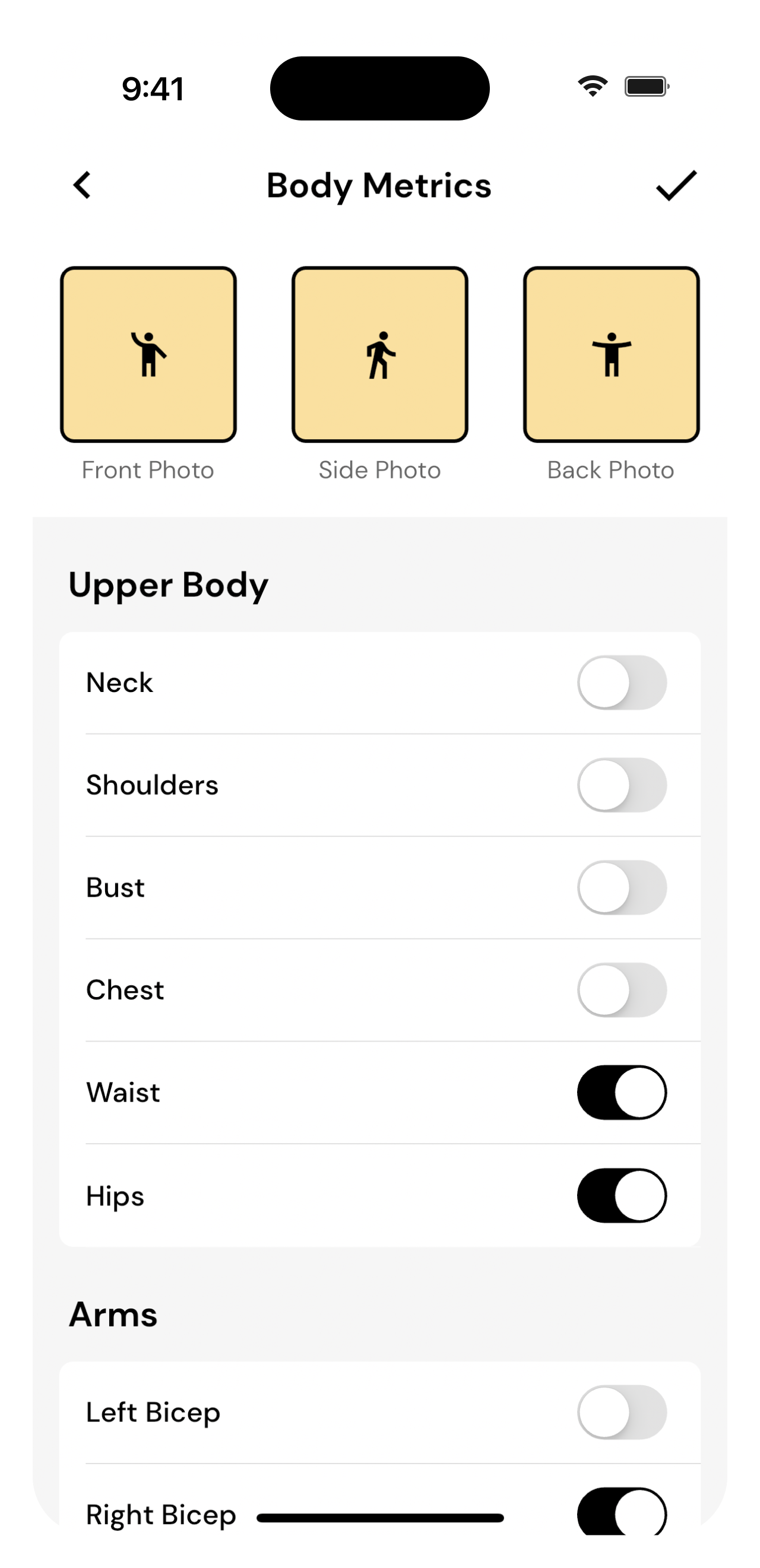
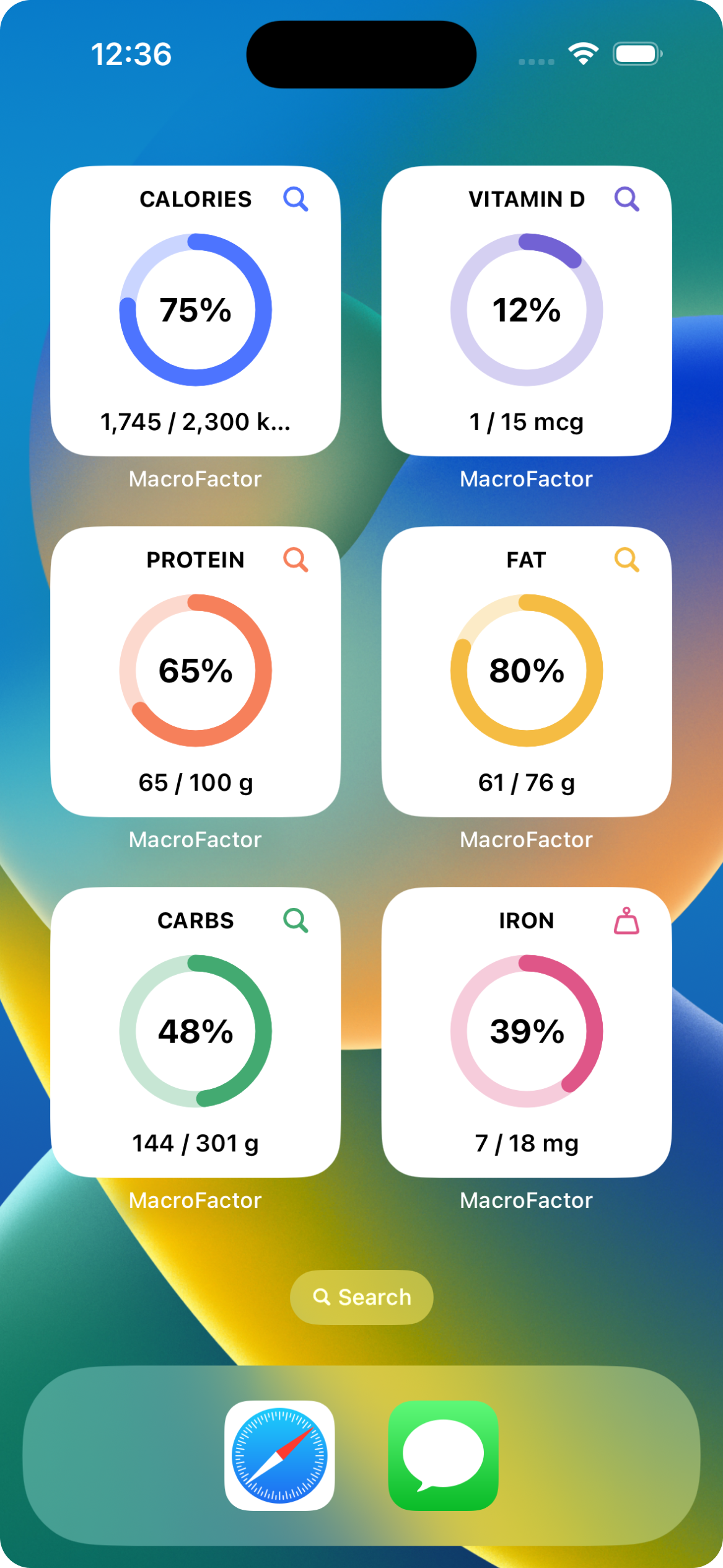
Widgets
Evaluate the day’s nutrition at a glance, and take actions faster than ever before with customizable home and lock screen widgets.
Label scanner
Effortlessly create and track new foods with MacroFactor’s fast, convenient label scanning.
Quickly scan calorie, macronutrient, and micronutrient details directly from food labels, then watch as the information populates in real time in the app.
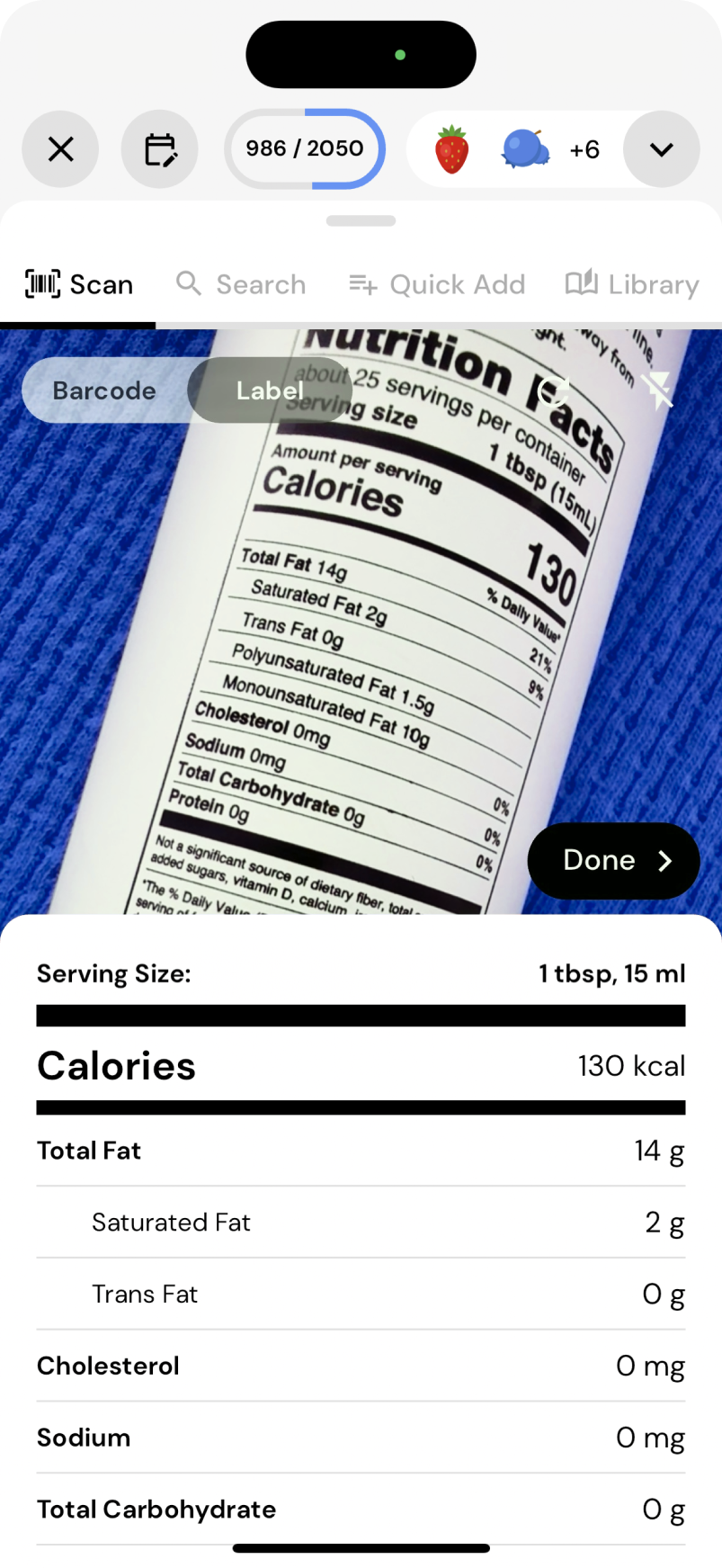

Science-based sustainability
Using the latest nutrition and behavior change science, MacroFactor is designed to maximize the likelihood that you’ll achieve your goals and be able to maintain (or build upon) your results.
It is one of the only nutrition coach apps that flexibly adapts to your goals and lifestyle, and helps you avoid any unnecessary stress, anxiety, or feelings of shame and guilt.
Feature Breakdown
Track your nutrition, monitor your progress, and glean useful data insights. MacroFactor’s thoughtfully designed features make it easy and beautiful.
Macro Program features
- Coached, Collaborative, and Manual modes
- Low-carb, keto, carb-focused, and balanced diet plans
- Set different macros for different days
- Support for fasting days
Food Logger features
- Barcode scanner
- Verified food search database
- Nutrition label scanner
- Custom food and recipes
- Copy and paste foods, meals, or entire days
- Smart history
- Speech-to-text food logging
- Metric and imperial options
Nutrition Coaching features
- Bulk, cut, and maintenance goal settings
- Dynamic weekly adjustments
- Adherence neutral
- Goal ETA insights
- Select preferred rate of weight change
- Change your goal any time
Analytics and Insights features
- Energy expenditure estimate
- Weight trend
- Nutrition and weight habits
- Weekly, monthly, and historical nutrition averages
- Top contributors for any macro- or micronutrient
- Nutrient timing insights
- Integrations with Apple Health and Google Fit
- Home and lock screen widgets
Tracking features
- Macro tracking
- Weight tracking
- Period tracking
- Habit tracking for logging streaks
- Full micronutrient tracking
- Body measurement tracking
- Progress photo tracking
Privacy features
- No ads
- Data is private and will never be sold
- Export your data any time
How MacroFactor Works
Get a dynamic, science-backed nutrition plan that's perfectly calibrated for you and your goals.

Step 1
Answer a few questions
Tell us about your lifestyle, goals, food preferences, and training demands.
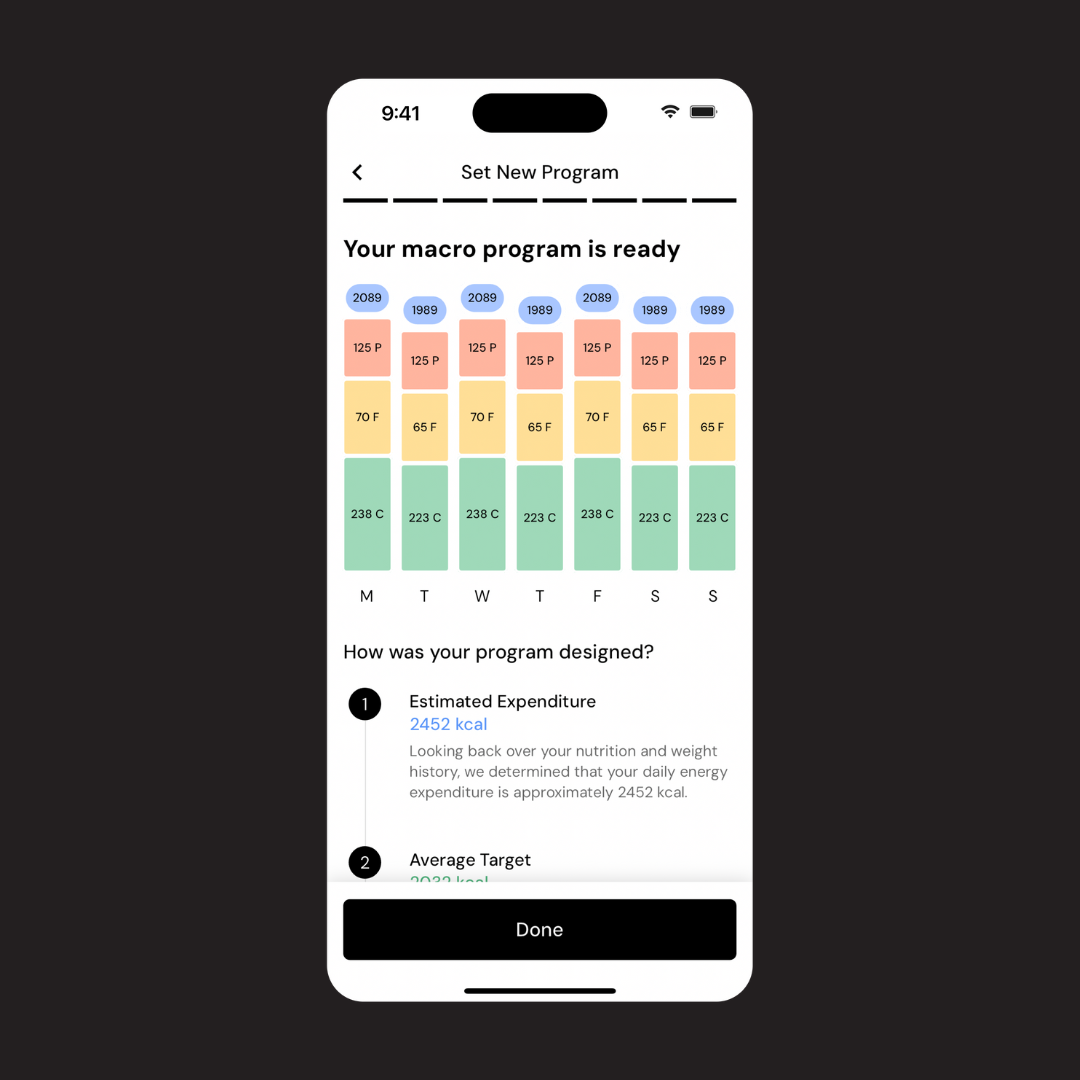
Step 2
Get your program
MacroFactor will recommend custom calorie and macronutrient targets for you based on your goals and the latest science.

Step 3
Log your weight and nutrition
Take a few minutes per day to log your weight and the foods you eat, so MacroFactor can calculate your energy expenditure and caloric needs with even greater precision.

Step 4
Check in weekly to get smart macro plan updates
During the Check-In, the MF Coach will ask you relevant questions, suggest novels changes to your macro program, and make personalized adjustments based on your data and feedback.
Ad-free, privacy-first experience
Premium by design
Month to month
Charged on a monthly basis.Yearly
Charged yearly for $71.99.Every 6 months
Charged every 6 months for $47.99Your subscription enables us to deliver the highest quality product and a user-focused experience.
- We will never serve ads or use ad networks to track you.
- Your subscription supports continuous enhancement of your experience.
- You have full access to all features and all of your data at all times.
- Top-notch customer support ensures you have a great experience.
- We offer a free trial so you can try before you buy.
Frequently asked questions
MacroFactor uses a verified food search database, so you can trust the nutrition information (unlike with MyFitnessPal’s unverified user-generated entries).
MacroFactor is the only app that makes calculations and adjustments based on what you actually did, not what you were supposed to do. The app’s smart algorithms make appropriate adjustments to your calorie and macro targets based on what you log, regardless of how close you came to hitting your targets.
Additionally, MacroFactor quantifiably has the fastest, most efficient food logger on the market. Logging a food in MacroFactor takes fewer taps than in any other app.
MacroFactor’s database covers most staple foods (fruits, vegetables, meats, grains, dairy products) worldwide.
In addition, the app has excellent barcode support in the US, Canada, the UK, Australia, Ireland, New Zealand, Japan, France, and Spain. The barcode support is quickly improving in Germany, as well.
Countries outside of those may see fewer localized options, but barcode support is growing over time, and users can still log from the huge library of common foods, add custom foods and recipes for local foods, and use the Label Scanner functionality to quickly scan and add any food with a nutrition label.
MacroFactor’s partnership with Open Food Facts also allows users to submit high-quality food data to be reviewed and added to the database. This means that users worldwide can take an active role in improving MacroFactor’s coverage of foods from their country.
We are always working to improve branded product and barcode support for everyone. We have a strong track record of expansion in this domain (with several big updates over the last year alone), and we are in the midst of a several-phase plan for massively expanding coverage in Europe and worldwide.
No, there isn’t (and will never be) a free version – for a few reasons.
MacroFactor is ad-free and focused on creating a premium, best-in-class user experience. Our aim is to provide the best tool for the job.
Furthermore, since the app is premium-only, we are able to offer a better service than the premium tier of other apps at a lower price (MacroFactor is $71.99/yr, vs. $79.99 for MyFitnessPal premium). We don’t need to defray the cost of free users by littering the app with ads and selling user data.
Finally, a premium-only business model ensures that our interests are always aligned with the interests of our users. When anyone could leave MacroFactor for a free alternative, the only way we succeed is by creating a truly exceptional product for our users.
MacroFactor’s prices are set at a competitive rate, though, and you have the option to choose from three subscription options to find the one that works best for you.
We do also offer a free trial, so you can try it out before being charged.
Currently, we don’t pull data from smart watches or activity trackers for one simple reason: they don’t seem to do a particularly good job of estimating energy expenditure.
Instead, we look at trended weight changes and compare those changes to calorie intake in order to back-calculate energy expenditure. We have some ideas about how we may be able to use activity data to further tweak and fine-tune our energy expenditure estimations at the margins, so we do plan on allowing users to integrate with activity trackers eventually (so we can empirically test those ideas). But for now, data from activity trackers wouldn’t affect the core functionality of the app: weight and nutrition data give us all the information we need to generate and adjust macro programs.
Not right now, but that’s something we’re planning on adding in the future.
Yes! Through our integrations with Apple Health and Google Fit, MacroFactor supports historical import of the last 30 days of data. This is more than enough to kickstart our analytics, and give you highly optimized recommendations on day one.
We don’t currently have a built-in coaching portal to allow you to see and manage your clients’ nutrition programs in-app. However, we make it easy for users to take screenshots of their nutrition information for the past week, and more importantly, we make it easy for users to export their daily weight, calorie intake, and macronutrient intake data to a spreadsheet, which they could send to a coach. MacroFactor also allows users to set custom macro targets day-to-day, which will make it simple for your clients to adjust their daily targets to match your recommendations. MacroFactor also supplies information that other apps don’t, including sophisticated weight trending and updating estimations of daily energy expenditure, which might help you make better diet adjustments for your clients. In short, we’re not going to pretend that MacroFactor is a game changer for nutrition coaches, but, relative to other nutrition apps, it should reduce a bit of friction to make your life (and your clients’ lives) a little easier.
Your estimated energy expenditure is a deterministic calculation based on your calorie intake and changes in body weight.
We start with the basic energy balance equation: Calories in – Calories out = Change in stored energy (and changes in stored energy obviously come with changes in weight over time). Since we want to estimate your energy expenditure, we need to rearrange the equation to solve for “Calories out”: Calories in – Change in stored energy = Calories out.
“Calories in” is simple to calculate, since you’re either logging your food in MacroFactor, or importing nutrition information from another source that’s synced with this app. “Change in stored energy” is slightly tougher to estimate, since we’re ultimately working with weight data. However, we can use information about your rate of weight change and the caloric content of fat tissue versus lean tissue to estimate the change in stored energy associated with your changes in weight (fat has a greater energy density than lean mass; at slower rates of weight loss or faster rates of weight gain, we anticipate that a larger proportion of the weight you gained or lost came from fat mass). From there, it’s simply a matter of solving the equation.
For example, if we estimate that you’ve been in an energy surplus of 200 Calories per day based on the rate at which your weight has been changing, and we can see that you’ve been eating approximately 3000 Calories per day, we can calculate that your daily energy expenditure is approximately 3000 – 200 = 2800 Calories.
As you continue to use MacroFactor, we’ll continue monitoring your energy intake and changes in weight to update your calculated energy expenditure. If you gain or lose a substantial amount of weight, or if your activity levels change, we won’t have to guess how those changes will impact your daily energy expenditure; we’ll be able to measure the impact, and adjust your calorie and macro recommendations accordingly.
Since our calculation of your energy expenditure is based solely on tracked energy intake and changes in weight, that allows our calorie and macro adjustments and recommendations to be “adherence-neutral.” In other words, you don’t have to be a robot with perfect dietary adherence for MacroFactor to make appropriate updates to your calorie and macro recommendations, based on your goals. If you eat a little more or a little less one week than your macro program recommended, that’s totally fine! Your updated calorie and macro recommendations for the next week are based on your actual energy intake and changes in weight, not how well you stuck to our recommendations. Not only does this allow our systems to be more robust to deviations from your macro program (which are totally fine; we don’t expect people to be robots), but we also hope that this “adherence-neutral” system will make deviations from your macro program less psychologically stressful. Since our system doesn’t require or expect perfect dietary adherence to make appropriate updates to your calorie and macro targets, that should lessen the perceived psychological cost of occasionally deviating from your recommended calorie targets.
As one final note, this calculation of energy expenditure is really at the heart of MacroFactor, and a lot of work has gone into ensuring that it’s as accurate and reliable as possible, given what we know about human physiology and metabolism. We’ve also taken great care to make it as robust as possible to less-than-perfect tracking (the more consistently you track your weight and nutrition, the better our recommendations will be, but if you occasionally forget to log your weight or nutrition, our algorithms still do an admirable job of rolling with the punches). However, it has one Achilles heel: partial nutrition tracking. If, for example, you track your breakfast and lunch one day, but you don’t put your dinner in the Food Log, we have no way of knowing that your energy intake for the day is incorrect, and your estimated daily energy expenditure (and future calorie recommendations) will decrease accordingly. However, as long as you avoid partial nutrition tracking, we should be able to accurately and reliably estimate your energy expenditure, and therefore recommend and appropriately adjust calorie and macro targets for you based on your goals.



